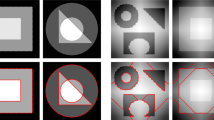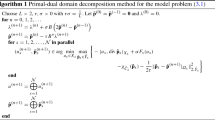Abstract
This paper concerns with the non-overlapping domain decomposition methods (DDMs) for the Chan–Vese model in variational image segmentation. We work with a saddle point formulation for the non-overlapping decompositions, which leads to independent subproblems decoupled by the primal–dual algorithm. With the non-overlapping DDMs, only the interfaces of the adjacent subdomains are coupled, which means the information transmission takes place on such interfaces and therefore makes the proposed DDMs flexible and efficient. Moreover, we consider both the stripe-type and checkerboard-type decomposition methods and provide the rigorous proof of the convergence. Our numerical experiments demonstrate that the proposed DDMs are convergent, efficient, and quite robust with respect to the model parameters and image resolutions.












Similar content being viewed by others
References
Sonka, M., Hlavac, V., Boyle, R.: Image Processing, Analysis, and Machine Vision. Cengage Learning, Boston (2014)
Kass, M., Witkin, A., Terzopoulos, D.: Snakes: active contour models. Int. J. Comput. Vis. 1(4), 321–331 (1988)
Caselles, V., Catté, F., Coll, T., Dibos, F.: A geometric model for active contours in image processing. Numer. Math. 66(1), 1–31 (1993)
Malladi, R., Sethian, J.A., Vemuri, B.C.: Shape modeling with front propagation: a level set approach. IEEE Trans. Pattern Anal. Mach. Intell. 17(2), 158–175 (1995)
Caselles, V., Kimmel, R., Sapiro, G.: Geodesic active contours. Int. J. Comput. Vis. 22(1), 61–79 (1997)
Mumford, D., Shah, J.: Optimal approximations by piecewise smooth functions and associated variational problems. Commun. Pure Appl. Math. 42(5), 577–685 (1989)
Chan, T.F., Vese, L.A.: Active contours without edges. IEEE Trans. Image Process. 10(2), 266–277 (2001)
Osher, S., Sethian, J.A.: Fronts propagating with curvature-dependent speed: algorithms based on Hamilton–Jacobi formulations. J. Comput. Phys. 79(1), 12–49 (1988)
Rudin, L., Osher, S., Fatemi, E.: Nonlinear total variation noise removal algorithm. Phys. D 60, 259–268 (1992)
Chan, T.F., Esedoglu, S., Nikolova, M.: Algorithms for finding global minimizers of image segmentation and denoising models. SIAM J. Appl. Math. 66(5), 1632–1648 (2006)
Vese, L.A., Chan, T.F.: A multiphase level set framework for image segmentation using the Mumford and Shah model. Int. J. Comput. Vis. 50(3), 271–293 (2002)
Bae, E., Yuan, J., Tai, X.-C.: Global minimization for continuous multiphase partitioning problems using a dual approach. Int. J. Comput. Vis. 92, 112–129 (2011)
Brown, E., Chan, T., Bresson, X.: Completely convex formulation of the Chan–Vese image segmentation model. Int. J. Comput. Vis. 98, 103–121 (2012)
Chambolle, A., Cremers, D., Pock, T.: A convex approach to minimal partitions. SIAM J. Imaging Sci. 5, 1113–1158 (2012)
Scherzer, O. (ed.): Handbook of Mathematical Methods in Imaging. Springer, New York (2011)
Acar, R., Vogel, C.: Analysis of bounded variation penalty methods for ill-posed problems. Inverse Probl. 10, 1217–1230 (1994)
Marquina, A., Osher, S.: Explicit algorithms for a new time dependent model based on level set motion for nonlinear deblurring and noise removal. SIAM J. Sci. Comput. 22, 387–405 (2000)
Vogel, C.: A multigrid method for total variation-based image denoising. In: Bowers, K.L., Lund, J. (eds.) Computation and Control IV, Progress in Systems and Control Theory, vol. 20, pp. 323–331. Birkhäuser, Boston (1995)
Vogel, C.: Computational Methods for Inverse Problems. SIAM, Philadelphia (2002)
Vogel, C., Oman, M.: Iterative methods for total variation denoising. SIAM J. Sci. Comput. 17, 227–238 (1996)
Vogel, C.: Fast, robust total variation-based reconstruction of noisy, blurred images. IEEE Trans. Image Process. 7, 813–824 (1998)
Goldstein, T., Osher, S.: The split Bregman method for \(l^1\)-regularized problems. SIAM J. Imaging Sci. 2, 323–343 (2009)
Wang, Y., Yang, J., Yin, W., Zhang, Y.: A new alternating minimization algorithm for total variation image reconstruction. SIAM J. Imaging Sci. 1, 248–272 (2008)
Glowinski, R., Tallec, P.: Augmented Lagrangian and Operator-Splitting Methods in Nonlinear Mechanics. SIAM, Philadelphia (1989)
Wu, C., Tai, X.-C.: Augmented Lagrangian method, dual methods and split-Bregman iterations for ROF, vectorial TV and higher order models. SIAM J. Imaging Sci. 3, 300–339 (2010)
Boyd, S., Parikh, N., Chu, E., Peleato, B., Eckstein, J.: Distributed optimization and statistical learning via the alternating direction method of multipliers. Found. Trends\(\textregistered \) Mach. Learn. 3(1), 1–122 (2011)
Chan, R.H., Tao, M., Yuan, X.: Constrained total variational deblurring models and fast algorithms based on alternating direction method of multipliers. SIAM J. Imaging Sci. 6(1), 680–697 (2013)
Chambolle, A.: An algorithm for total variation minimization and applications. J. Math. Imaging Vis. 20(1–2), 89–97 (2004)
Appleton, B., Talbot, H.: Globally optimal geodesic active contours. J. Math. Imaging Vis. 23, 67–86 (2005)
Arrow, K., Hurwicz, L., Uzawa, H.: Studies in linear and non-linear programming, with contributions by H. B. Chenery, S. M. Johnson, S. Karlin, T. Marschak, R. M. Solow. Stanford Mathematical Studies in the Social Sciences, vol. II. Stanford University Press, Stanford (1958)
Chambolle, A., Pock, T.: A first-order primal-dual algorithm for convex problems with applications to imaging. J. Math. Imaging Vis. 40(1), 120–145 (2011)
Zhu, M., Chan, T.: An efficient primal-dual hybrid gradient algorithm for total variation image restoration. UCLA, pp. 08–34. Center for Applied Math, CAM Reports No (2008)
He, B., Yuan, X.: Convergence analysis of primal-dual algorithms for a saddle-point problem: from contraction perspective. SIAM J. Imaging Sci. 5, 119–149 (2012)
Tai, X.-C.: Rate of convergence for some constraint decomposition methods for nonlinear variational inequalities. Numer. Math. 93, 755–786 (2003)
Tai, X.-C., Espedal, M.: Applications of a space decomposition method to linear and nonlinear elliptic problems. Numer. Methods Partial Differ. Equ. 14, 717–737 (1998)
Tai, X.-C., Espedal, M.: Rate of convergence of some space decomposition methods for linear and nonlinear problems. SIAM J. Numer. Anal. 35, 1558–1570 (1998)
Tai, X.-C., Xu, J.: Global and uniform convergence of subspace correction methods for some convex optimization problems. Math. Comput. 71, 105–124 (2002)
Firsov, D., Lui, S.H.: Domain decomposition methods in image denoising using Gaussian curvature. J. Comput. Appl. Math. 193, 460–473 (2006)
Müller, J.: Parallel total variation minimization. University of Muenster, Diploma Thesis (2008)
Duan, Y., Tai, X.C.: Domain decomposition methods with graph cuts algorithms for total variation minimization. Adv. Comput. Math. 36, 175–199 (2012)
Tai, X.-C., Duan, Y.: Domain decomposition methods with graph cuts algorithms for image segmentation. Int. J. Numer. Anal. Model. 8, 137–155 (2011)
Xu, J., Tai, X.-C., Wang, L.-L.: A two-level domain decomposition method for image restoration. Inverse Probl. Imaging 4, 523–545 (2010)
Xu, J., Chang, H., Qin, J.: Domain decomposition method for image deblurring. J. Comput. Appl. Math. 271, 401–414 (2014)
Chang, H., Zhang, X., Tai, X.-C., Yang, D.: Domain decomposition methods for nonlocal total variation image restoration. J. Sci. Comput. 60, 79–100 (2014)
Chang, H., Tai, X.-C., Yang, D.: Domain decomposition methods for total variation minimization. In: Tai, X.-C., et al. (eds.) Energy Minimization Methods in Computer Vision and Pattern Recognition, vol. 8932. LNCS, Springer, Berlin (2015)
Chang, H., Tai, X.-C., Wang, L.-L., Yang, D.: Convergence rate of overlapping domain decomposition methods for the Rudin–Osher–Fatami model based on a dual formulation. SIAM J. Imaging Sci. 8, 564–591 (2015)
Fornasier, M., Schönlieb, C.: Subspace correction methods for total variation and \(l_1\) minimization. SIAM J. Numer. Anal. 47, 3397–3428 (2009)
Fornasier, M., Langer, A., Schönlieb, C.: A convergent overlapping domain decomposition method for total variation minimization. Numer. Math. 116, 645–685 (2010)
Hintermüller, M., Langer, A.: Subspace correction methods for a class of nonsmooth and nonadditive convex variational problems with mixed \(l^1\)/\(l^2\) data-fidelity in image processing. SIAM J. Imaging Sci. 6, 2134–2173 (2013)
Langer, A., Osher, S., Schonlieb, C.: Bregmanized domain decomposition for image restoration. J. Sci. Comput. 54, 549–576 (2013)
Hintermüller, M., Langer, A.: Non-overlapping domain decomposition methods for dual total variation based image denoising. J. Sci. Comput. 62, 456–481 (2015)
Lee, C., Lee, J., Woo, H., Yun, S.: Block decomposition methods for total variation by primal-dual stitching. J. Sci. Comput. (2015). doi:10.1007/s10915-015-0138-9
Chang, H., Tai, X.-C., Wang, L.-L., Yang, D.: Convergence rate of overlapping domain decomposition methods for the Rudin–Osher–Fatami model based on a dual formulation. SIAM J. Imaging Sci. 8(1), 564–591 (2015)
Kunisch, K., Tai, X.-C.: Nonoverlapping domain decomposition methods for inverse problems. In: Bjorstard, P., Espedal, M., Keyes, D. (eds.) Proceedings of 9th International Conference on Domain Decompostion Methods. Wiley (1997)
Boyd, S., Lin, X., Almir, M., Jacob, M.: Notes on Decomposition Methods. Notes for EE364B. Stanford University, Stanford (2007)
Lions, P.: On Schwarz Alternating Method III: A Variant for Nonoverlapping Subdomains. SIAM, Philadelphia (1990)
Chambolle, A., Pock, T.: A first-order primal-dual algorithm for convex problems with applications to imaging. J. Math. Imaging Vis. 40(1), 120–145 (2011)
Pascal, G.: tvreg v2: variational imaging methods for denoising, deconvolution, inpainting, and segmentation (2010)
Chang, H., Zhang, X., Tai, X.-C., Yang, D.: Domain decomposition methods for nonlocal total variation image restoration. J. Sci. Comput. 60(1), 79–100 (2014)
Wei, K., Tai, X.-C., Chan, T.F., Leung, S.: Primal-dual method for continuous max-flow approaches, vol. pp. 15–67. UCLA CAM Report (2015)
Author information
Authors and Affiliations
Corresponding author
Additional information
The research was partially supported by Natural Science Foundation of China, Grant No. 11426165, No. 11501413 and Tianjin 131 Talent Project.
Appendix
Appendix
There are many solvers to minimize (2.1) including the primal–dual algorithm [57]. The saddle point problem of (2.1) is built up as follows:
where

By defining \(G_1(h)=\alpha \int _\Omega s h +I_{K_h}(h)\) and \(G_2({\varvec{p}})=I_{K_p}({\varvec{p}})\), Eq. (5.1) reduces to the following form:

The primal–dual algorithm by Chambolle and Pock [31] can be used to solve the above problem.

Both subproblems of \(\varvec{p}\) and h in Eq. (5.3) have the closed-form forms, which are
and
Theorem 5.1
([31]) The primal–dual algorithm is convergent if \(\tau \sigma <1/8.\)
Rights and permissions
About this article
Cite this article
Duan, Y., Chang, H. & Tai, XC. Convergent Non-overlapping Domain Decomposition Methods for Variational Image Segmentation. J Sci Comput 69, 532–555 (2016). https://doi.org/10.1007/s10915-016-0207-8
Received:
Revised:
Accepted:
Published:
Issue Date:
DOI: https://doi.org/10.1007/s10915-016-0207-8




